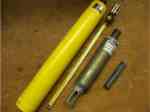|
|
The data in this archive include measurements of water properties such as temperature, salinity, dissolved oxygen, pH, chlorophyll a, nitrate concentration and turbidity (water clarity). Instruments that obtain these measurements typically store the observations from one or more sensors. The sensors may be an integral part of the logger, or attached by cables, allowing the individual sensors to be mounted at different heights. The instruments may be attached to a mooring or mounted on bottom platforms.
Temperature Loggers
A temperature logger measures temperature at the sensor and logs it at programmed intervals. Many current meters also measure and record temperature. Some thermistors are separate sensors that provide nearly instantaneous measurements of temperature, whereas others are embedded in the instrument pressure housing with a response time of minutes. Measurements made with a variety of sensors are included in the time-series database; observations from Sea-Bird temperature probes are most common (fig. 17). The SBE-3 sensor is used in most Sea-Bird instrumentation. The SBE-3 is accurate to ± 0.001 °C with a stability of ± 0.002 °C per year and calibrations are National Institute of Standards and Technology (NIST)-traceable. More information can be found at http://www.seabird.com. USGS has also used high accuracy (±0.002 °C) RBR Ltd. Model TR-100, TR-1050, and Solo-T oceanographic temperature loggers on subsurface moorings. More information can be found at the manufacturer's Web site, http://www.rbr-global.com/. Also used are small, inexpensive Vemco minilogger instruments that are accurate to ±0.2 °C. Typical sampling rates are 5 to 15 minutes.
Conductivity and Salinity Measurements
Salinity is calculated from measurements of water conductivity, temperature, and pressure. The several types of conductivity sensors manufactured generally fall into inductive and conductive classes. The type used depends on the deployment platform, location, amount of expected fouling, and effectiveness of methods used to prevent fouling of the sensor. Almost all of the USGS data have been acquired using the Sea-Bird SBE-4 conductivity cell. The sensing element is a cylindrical, flow-through, borosilicate glass cell with three internal platinum electrodes. They are accurate to 0.0003 siemens per meter (S/m) and calibrations are NIST-traceable. More information can be found at http://www.seabird.com/ and the paper by Peterson and Gregg (1979). Conductivity cells are prone to biofouling and sediment accumulation that can result in a gradual decrease in measured conductivity during the course of a deployment, resulting in an erroneous drop in the calculated salinity.
Sea-Bird MicroCAT
The Sea-Bird MicroCAT conductivity-temperature-depth profiler (CTD) (http://www.seabird.com/) is a low cost full ocean capable datalogger that records output from integral SBE-3 temperature and SBE-4 conductivity cells (fig. 18). Data are recorded internally on FLASH RAM memory. They are used where salinity and temperature measurements are needed.
Sea-Bird SeaCAT
The Sea-Bird SeaCAT 16 (http://www.seabird.com/) is a versatile datalogger that records output from SBE-3 temperature and SBE-4 conductivity cells and, depending on options, can power and record additional sets of temperature and conductivity sensors as well as external sensors. These instruments can also flush the sensors to reduce fouling (fig. 19). They are used by USGS where salinity, temperature and other measurements (such as turbidity, see below) are required. When deployed on bottom tripods, the instruments can be equipped with pumps to flush the sensor ducts and reduce salinity errors resulting from sediment accumulation in the cells. Pumping generally is not necessary on moorings, because mooring motions flush the sensor and prevent sediments from accumulating in the conductivity cell. Auxiliary external sensors, such as those for dissolved oxygen, pH, or turbidity, may be attached to the instrument. Data are recorded internally on FLASH RAM memory.
YSI 6600 Series Sonde and YSI EXO
The YSI 6600 (fig 16, left [with IQ]) and EXO (fig. 20, top [with Aquadopp]) instruments are designed for internally recording water quality data with interchangeable probes. The EXO product line is a follow-on to the 6600 series. Both have sensors to measure temperature, conductivity, pressure, pH, dissolved oxygen, and turbidity. The EXO also can support sensors to measure chlorophyll a, fluorescent dissolved organic matter, and blue-green algae phycoerythrin. Both instruments use optical sensors and employ wipers to lessen biofouling. For more information, see https://www.ysi.com/products/multiparameter-sondes.
Nitrate Measurements
When measurements of nitrate levels or nutrient loading are required for research, a Satlantic ISUS is deployed.
Satlantic ISUS
The ISUS is a self-contained, battery-powered optical nitrate measurement and logging system. The sensor is able to detect concentrations between 0.5 and 2,000 micromoles (µmol), with accuracy of ±2 µmol. For more information, see http://satlantic.com/isus#.
|
Click on figures for larger images.

Figure 17. Temperature loggers: RBR TR–1050 temperature logger, Sea-Bird SBE–3 temperature probe, and VEMCO minilogger (left to right).

Figure 18. A Sea-Bird SBE-4 conductivity sensor.

Figure 19. A Sea-Bird SEACAT 16 conductivity and temperature sensor mounted with a Wetstar flurometer (foreground).

Figure 20. YSI EXO water quality sensor (top), with copper mesh to protect the probes prior to deployment in Chincoteague Bay, Maryland, 2014.
|